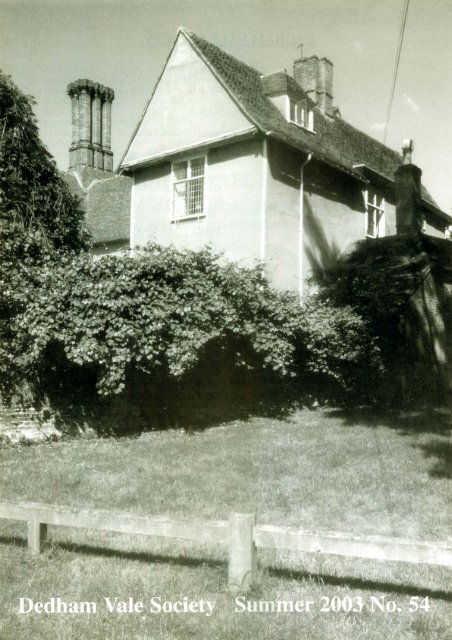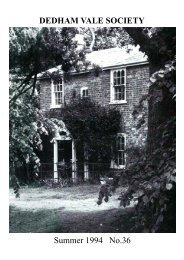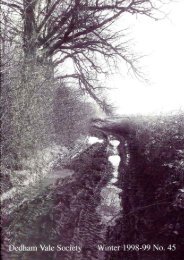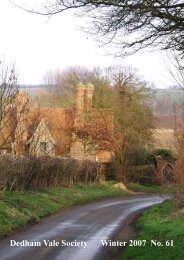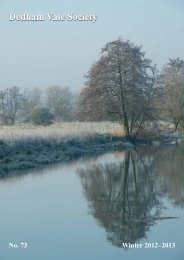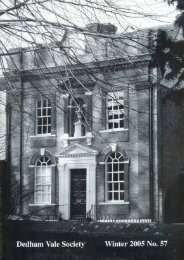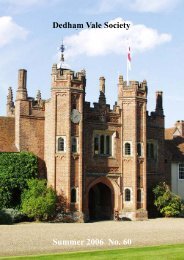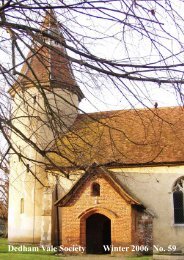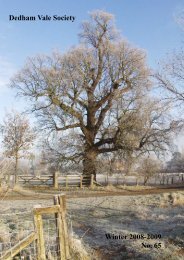Number 54 - Summer 2003 pdf 1.2Mb - Dedham Vale Society
Number 54 - Summer 2003 pdf 1.2Mb - Dedham Vale Society
Number 54 - Summer 2003 pdf 1.2Mb - Dedham Vale Society
- No tags were found...
You also want an ePaper? Increase the reach of your titles
YUMPU automatically turns print PDFs into web optimized ePapers that Google loves.
DEDHAM VALE SOCIETYPRESIDENTRobert Erith TD., D.L.CHAIRMANWilfrid TolhurstHONORARY TREASURERMichael ParkerJupes Hill House, <strong>Dedham</strong>Colchester CO7 6BJ01206 322133HONORARY SECRETARYSarah CarrGulson’s Farm, Boxted Church StreetColchester CO4 5SX01206 272207PLANNING OFFICER(Suffolk)David EkingFarthings, Thorington StreetStoke-by-Nayland CO6 4SP01206 337477JOINT PLANNING OFFICERS(Essex)Judith Fowle<strong>Dedham</strong>Dora NicholsLawfordNEWSLETTER EDITORPaul GallifantMill Cottage, Mill HillLawford, Manningtree, CO11 2JZ01206 394202MEMBERSHIP SECRETARYJohn OsbornBailey House, Brook Street,<strong>Dedham</strong>, Essex CO7 6AD01206 322157MEMBERS OF THE COMMITTEEMichael ArcherCharles CloverFrances DodgsonRobert ErithJeremy CohenTel: 01206 322169Tel: 01206 323503Tel: 01206 298346Tel: 01206 227520Tel: 01206 262219John FramptonAnn MacWilsonChristopher RobinsonQuinlan TerryNella ProbertTel: 01206 337249Tel: 01787 210335Tel: 01787 227179Tel: 01206 337209Tel: 01787 228095Front Cover Thorington Hall2
NEWSLETTER NUMBER <strong>54</strong> SUMMER <strong>2003</strong>CONTENTSAGM AgendaMinutes of AGM September 2002Statement of Accounts 2002/3N.A.T.S ProposalsEssex PlanningPlanning Notes - SuffolkThe <strong>Society</strong>'s New President Robert Erith - a profileThe MinkNew Strategy for <strong>Dedham</strong> <strong>Vale</strong>Page 2Page 3Page 6Page 7Page 7Page 8Page 11Page 14Page 18DEDHAM VALE SOCIETYANNUAL GENERAL MEETING - 22nd SEPTEMBER, <strong>2003</strong>NAYLAND VILLAGE HALL, CHURCH LANE, NAYLANDAGENDA1 Apologies for absence.2 Minutes: To receive the minutes of the Annual General Meeting held on 25th September,2002, as published in the summer newsletter.3 Planning Secretaries' reports: To receive the reports for 2002/3, as published in thenewsletters and to discuss the <strong>Vale</strong> and the <strong>Society</strong>.4 Honorary Treasurer's report: To receive the audited accounts for 2002 and to discussthe current financial position.5 Verification of accounts for 2004: To make arrangements.6 Officers and committee6.1 To confirm the appointment of Robert Erith as President of the <strong>Society</strong>.6.2 To confirm membership of committee (all due to retire in <strong>2003</strong> are willing to continueas committee members):To retire by rotation in <strong>2003</strong>: Charles Clover, Francis Dodgson, Paul GallifantTo retire by rotation in 2004: Robert Erith, John Frampton, Quinlan TerryTo retire by rotation in 2005: Michael Archer, Jeremy Cohen, Anne MacWillson6.3 To confirm the appointment of Nella Probert in place of Robert Erith.7 Membership of the <strong>Society</strong>: To receive details and discuss.8 Other business.9 The President's comments.10 Date and venue of next Annual General Meeting.11 Presentation by the <strong>Dedham</strong> <strong>Vale</strong> & Stour Valley Project.3
5. VERIFICATION OF ACCOUNTS FOR 2002Clifford Welch has kindly agreed to verify the accounts for 2002 and the chairmanexpressed the <strong>Society</strong>'s thanks to him.6. MEMBERSHIP OF COMMITTEEMichael Archer, Jeremy Cohen and Anne MacWillson were due to retire by rotationand, there being no other nominations, they will continue as committee members. DavidCoombs' place on the committee has been taken by Francis Dodgson.7. MEMBERSHIP OF THE SOCIETYJohn Osborn reported that the party held at Castle House, <strong>Dedham</strong> in May had beensuccessful in recruiting new members and that membership numbers now stood as follows:Total number of members as at 25.09.02 736Residing at 468 addresses<strong>Number</strong> of new members since 02.07.01 126Residing at 73 addressesMembership by area:<strong>Dedham</strong> 155, Stoke by Nayland 95, Nayland 88, Boxted 48, East Bergholt 37,Higham 34, Langham 28, Polstead 27, Stratford St. Mary 25, Lawford 21,Bures 19, Great Horkesley 15, Leavenheath 9.Of the total membership, payment method is as follows: _Annual cash 47 (10%)Bankers order 135 (29%)Life membership 281 (61%)8. ANY OTHER BUSINESSRobert Erith asked that the <strong>Society</strong> should pay tribute to John Constable, who had diedrecently. He had shown considerable courage in standing up against the River Stour Trust andit was wished that he had become a member of the <strong>Society</strong>.Robert Erith asked that the <strong>Society</strong> should write to Lady Abinger following LordAbinger's death. He had been on the committee for some years and the <strong>Society</strong> had strong linkswith him as president of the Colne/Stour Association.George Curtis suggested that a complaint be made to English Heritage about the appallingacoustics of the Assembly Rooms.Martin Crawshay asked if the <strong>Society</strong> was taking a position on the Stansted expansionplans and David Eking replied that the matter was indeed in hand.5
N.A.T.S. FLIGHTP A TH PROPOSALS TO COME INTO EFFECT IN MARCH 2004For a number of operational reasons, the National Air Traffic Services Ltd (NATS),which controls the use of UK airspace, is planning to make changes to flightpaths over East Anglia.This is to be achieved in a joint proposal with the Ministry of Defence (MOD) whereby the latter willrelinquish airspace over Suffolk. The changes are primarily being made because of overcrowding atthe Clacton Beacon, the point used since 1999 for many flights East to West over the <strong>Dedham</strong><strong>Vale</strong> AONB.NATS has also responded to the strong representations from the <strong>Dedham</strong> <strong>Vale</strong> <strong>Society</strong>(DVS), the Colne Stour Countryside Association (CSCA) and numerous individuals concerned atthe noise of a commercial jet flightpath destroying the tranquillity of the AONB, and nowproposes to re-route the main East-West flightpath.From 18th March 2004, incoming aircraft will be directed to a point North East of Ipswich,code-named LAPRA, to the Abbot hold North West of Sudbury, from which aeroplanes willdescend to Stansted and Luton. These aircraft will be flying some 2,000ft higher than thosepresently overflying the AONB and the disturbance under the new flight path will be substantiallyless than it is for us at present.In addition, the main flightpaths from West to East from Manchester and Midlandsairports, will be re-routed across North Suffolk rather than over the Stour valley, as at present.This does not mean that there will never be aircraft over the <strong>Vale</strong>. Unpressurised aircraftcannot use the new route and will continue to be directed as at present, but these are essentiallypropeller driven and relatively few in number. NA TS also emphasise that they cannot guaranteethat pressurised craft will not over fly the <strong>Dedham</strong> <strong>Vale</strong>, even with the new airspace structure,because controllers must be able to utilise the full extent of controlled airspace in order to ensuresafety to the aircraft operating within it.Whilst not all parts of the AONB are currently affected by aircraft noise, this situationwould inevitably have changed as flightpaths become busier. The fact that the <strong>Dedham</strong> <strong>Vale</strong> willno longer be under the main flightpath is greatly to be welcomed and will bring intense relief toall those now suffering from excessive aircraft noise.Robert Erith President, <strong>Dedham</strong> <strong>Vale</strong> <strong>Society</strong>ESSEX PLANNINGIt has been a quiet summer on the planning front! The telecommunications companiescontinue to apply regularly for new masts with their accompanying entourage of huts and boxshaped buildings. They seem to be especially keen to build something in the Jupes Hill area ofthe <strong>Vale</strong>. In principle, we are against these masts being built in the A.O.N.B., or as a "necklace"around it, and will continue to object to these applications. Otherwise we await the outcome ofthe appeals regarding the refusal of applications for substantial developments at Lawford Place,near Manningtree, and the Bunting's site at Great HorkesleyDora Nichols,Judith A Fowle8
Telephone Mast - Hill Farm, <strong>Dedham</strong>A site meeting was convened on the 16th July when Orange invited representatives fromlocal organisations to attend in order to address their concerns about the plan for a mast at HillFarm. A number of plans have been refused so far, the last being a "dead tree", but Orange havenow suggested moving the mast and the associated base-station nearer to a small copse on thefarm. At the meeting a mock-up of a l5metre single pole type was erected and it certainlyappeared to be less intrusive than previous ideas. But it was still very visible from the top of thehill where the Essex Way footpath meets the road just south of <strong>Dedham</strong>. In winter it would beeven more obvious.I have attended several planning meetings at Co1chester Town Hall where the committeehave voted unanimously to refuse consent. I think that this policy should continue because thereis considerable risk of other companies applying for their own masts once the boundary of theAONB has been breached by Orange.The mast is needed to facilitate mobile phone conversations on train journeys betweenManningtree and Ardleigh. (Editor)PLANNING NOTES - SUFFOLK - SUMMER <strong>2003</strong>If these brief lapse into barely intelligible jargon please forgive me. Over the last sixmonths I have read and commented upon two large documents put out by the local authority.The first, "Babergh Local Plan Alteration No 2 - Second Deposit Draft" is a two-handed liftand has nearly four hundred pages. Both are written in a language that can perhaps be bestdescribed as "localese". After a time I became so immersed in this ponderous local authorityspeak that r found myself writing it.The second draft of the new Local Plan, which sets out the policies and criteria uponwhich local planning decisions are supposed to be based, is a much better document than thefirst draft. With some exceptions, if it is followed faithfully, many of the planning errors whichhave been visited upon the AONB in recent years should be avoided or at least ameliorated.However, there is still no clear or strong guidance on the avoidance of Noise Pollution, there isa tacit acceptance that Telecommunication Masts are inevitable even in the AONB and policyon Housing Development in the Countryside is still obscure and potentially ineffective.The other document that needed careful study is the Consultation Draft of the "<strong>Dedham</strong><strong>Vale</strong> (AONB) and Stour Valley Management Strategy" which has been produced in accordancewith the requirements of the Countryside and Rights of Way Act 2002. This act requires all LocalAuthorities with an AONB in their area to prepare, publish and review regularly a strategy for theAONB in question. Despite the jargon this document is a step forward. It does give pre-eminence tothe need to preserve not only the physical beauty of the AONB but also the quality of life withinit. However, this is only a consultation draft and the final document is some way off and evenwhen it is finalised it remains to be seen how far the agreed strategies will be actually followed.Centre - Pages 9 and 10. Cutting beans at Weylands Farm, Thorington Street.Roger Clarke is seated on the binder having completed the afternoon's work. Thephotograph was taken some years ago but Weylands Farm still operates on horse-power.9
(Suffolk Planning Notes - continued)Now to more immediate concerns. The applicant at Mount Pleasant, Lower Raydon, towhich I referred last time, appealed against the District Council's refusal to allow the demolitionof two Victorian Cottages and their replacement by a large modem house. His appeal was rejected.I quote part of a sentence of the Inspector's adjudication "In short the development proposedwould appear intrusive and incongruous in its setting and harmful to the natural beauty of thelandscape.. .. .." Hear, Hear!Telecommunication Masts in Stratford St Mary are still with us. Yet another application byanother provider has appeared immediately alongside the site in Billy's Lane where permissionwas granted on appeal as I reported last time. The application is accompanied by a detailed caseas to why they cannot share the other provider's mast and/or that it would be even more intrusiveif they did. I am not hopeful that this can be resisted successfully.Also in Stratford St Mary an application by Pubmaster to build twelve little boxes on asmall strip of land behind the Anchor Inn was refused by the District Council. It is, however,unlikely to be the last application from this firm which owns all three Public Houses in the village.All of them have pieces of land on which houses could be built, at least in theory.The valley of the River Stour beyond Nayland towards Bures is under pressure again.Applications have been made for a polythene tunnel to store light aircraft at the airstrip atHarpers Hill, for yet further bams at Rushbanks Farm and an exceptionally large barn at Goody'sFarm. An agricultural case can be made for the latter two applications but the first appears tohave no merit. Even if the other two cases are made out it is inescapable that they will degradethe quality of this exceptional landscape.Otherwise there has not been much activity on the Suffolk side of the River. I keep aconstant eye on the continuing flow of minor "extensions" for which planning permission issought week after week. All too often they are not "minor" and particularly where the extensionis to a garden they can become distinctly intrusive. I am ashamed to admit that I was completelymisled by a most persuasive architect a year or so ago and agreed not to object to a particularproposal. I hang my head in shame every time I drive past the result which is sadly a prominentsite now sporting most of the facilities of a Country Club in what was formerly a pleasant,mature garden and adjacent fields. David Eking Planning Secretary, SuffolkThe <strong>Society</strong>'s New President, Robert Erith - a profile by Maureen CleaveRobert Erith farms 270 acres near Bures and from this farm, on a clear day, he can see 18churches: he can see Great Horkesley, Little Horkesley, Wormingford, Mount Bures, Lamarsh,Alphamstone, Great Henny, Great Cornard, Little Cornard, Sudbury St Gregory's. Sudbury StPeter's, Chilton, Stanstead, Long Melford, Glemsford, Alpheton, Lavenham (9 miles as the crowflies) and Bures, though of this - in spite of being well over 6 ft 4 inches tall- he can see only theflagpole. Now, because of very enthusiastic woodland planting, he is rather in danger of losingsight of two, but what better man to be President of the <strong>Dedham</strong> <strong>Vale</strong> <strong>Society</strong> when he can seeso much of it without stirring a step from home? "The founder-president," he said, " was AlfredMunnings and my Uncle, Raymond Erith followed him so I'm pretty chuffed to be in that company!"He took up the job officially in September but had already - with Wilf Tolhurst, theChairman, and our 3 MP's - sorted out the problem of the flight path to Luton and Stansted airports12
which went straight over the <strong>Vale</strong>. From next March this is to be moved, at a cost of nine millionpounds to National Air Traffic Services, to north of Ipswich and will be much higher."Soeverybody will gain," he said. "It just goes to show the <strong>Society</strong> can make a difference, thatwe are listened to if we present a good case in a reasoned way. The <strong>Dedham</strong> <strong>Vale</strong> was createdan AONB for its peaceful tranquil countryside and its association with Constable and that's howit must stay."He is 65 with farming in his blood though it took him some time to realise this. Hisancestors were yeoman farmers in East Anglia from the sixteenth century. His father Felix,(brother of Raymond Erith, the architect) farmed Vinces farm in Ardleigh. "It was during theagricultural depression of the thirties and nobody had a bean. I think my parents found it toughbut we three children knew nothing else - we had the whole countryside to play in. We wouldbe ordered out of the house after breakfast and we would make houses and forts and dens out ofthe potato trays. We had 150 acres, an old International tractor, threshing tackle we shared withtwo other farmers, six farm hands and four Suffolk punches. Everybody had working horsesthen. The horseman would be up at 4.30 in the morning to get them ready to start work at 7.They had to be groomed, fed, and the tackle put on them, and he would talk to them the wholetime in a private language.Robert and Sara Erith13
"The harvest was wonderful for a boy. When I was six, I had my first paid job which wasleading the horses between the traves (stooks) and holding their heads while the men pitched thesheaves up. At threshing, I was chaff-boy packing the chaff into sacks - a very dirty job."When we got to the bottom of the com stack all the rats and mice would run out and dogsand men with sticks of chestnut palings would chase after them. The men tied string round theirtrouser bottoms to stop the rats and mice running up their legs. Harvest, thrashing, haymaking - itwas such fun. The horses were all mares or geldings and the stallion would come once a year toservice them, which was quite an event - these are very big animals."Suddenly all that came to an end. In 1950 every farm in Essex and Suffolk had workinghorses and by 1960 there were practically none." He said there are now fewer Suffolk punches inthe world than there are giant pandas.He had been to Littlegarth in <strong>Dedham</strong> and Ipswich School as a boarder, and his fatherintended he should go to Writtle and eventually take over the farm. However, on his eighteenthbirthday he went into the army to do his national service for two years in the Tenth Hussars andby the time he arrived at Writtle everything had changed."I'd had my own personal soldier servant and my own driver. I'd done serious soldiering inthe Middle East. There were the friends I'd made and the smart parties and deb dances in London andI loved all that. Going to Writtle was like going back to school and I rather kicked over the tracesand flunked my exams. I was interested in politics and, whilst I didn't want to make lots of money,I didn't want to be poor."He went to London and worked on the shop floor of a builders' merchant in the East End,selling nuts and bolts to dockers. He still managed - and this was to be the habit of lifetime - toenjoy himself, more deb dances and meetings of the Bow Group of young Conservative politicalhopefuls, where friends included Geoffrey Howe, Patrick Jenkin and Tony Newton. He decided toemigrate to America, working for a firm called Hechinger, a sort of American Homebase inWashington. Here he somehow contrived to get pally with President Kennedy's secretary, a MrsLincoln. How he ended up doing six week's service with the Royal Scots Greys in Hong Kongand being regularly mistaken for the second in command of the squadron (who happened to be theDuke of Kent) is another story, but generals would salute him and gravely he would salute back.We next see him hitching a lift with the RAP from Hong Kong to Perth and later travellingall over Africa in a Land Rover. Home again after two years, instead of showing signs of settlingdown, he's showing rich Americans round London in his mother's car. At this point he met hisSara, his wife and later the mother of his three sons. Sara didn't seem to mind that he wasn't fullyemployed. They bought the house (with one cold tap which she didn't mind either) near Bures,and in 1966 he went into the City, becoming a stockbroking analyst with Savory Milln, advisinginvestors about companies in the building industry like Wimpey, Taylor Woodrow, McAlpine,Laing and so on. It was the building boom and all that experience with nuts and bolts came in useful.He wasn't doing badly for a man who failed maths O-level twice.He was selected as Conservative candidate for Ipswich in 1976, as a result getting pallywith Margaret Thatcher and John Major, in the election of 1979 getting the highest recorded Conservativevote but not big enough to win. "I liked politics, the cut and thrust, the feeling you mightbe able to get things done, be of service - a Trollopian idea which probably sounds a bit pompous."In 1997 he loved being High Sheriff of Essex, the 8pth high sheriff since the time of theSaxon kings when Essex was a separate kingdom. "I thought to be part of this historical cavalcadewas just a wonderful thing, I like the continuity of English life, the fact our history is evolutionaryrather than revolutionary - we've only had one revolution and that was reversed. Charles the Secondcame back as king and executed only the twelve regicides."14
In 1985, the City changed and the days of traditional stockbroking were over. Everybodysold out to everybody else and made lots of money and his firm were taken over by Swiss BankCorporation, he becoming chairman of their equities group. He was very busy, holding downeleven non-executive jobs at one time, but not too busy to keep an eye on other things.Here's an example of how he gets things done. "When Swiss Bank took over, we had thissmart office in Blackfriars. Across the river was a long yellow hoarding by Bankside power stationand on top of this was a cardboard cut-out of what looked like Snoopy but which turned out toShakespeare in a hard hat. I wandered over and behind the hoarding was a hole in the ground ofabout an acre and a sign saying Site of Shakespeare's Globe Theatre. Then it said, Inquiries toBear Gardens - after the bear pit in Shakespeare's time. I went round to this little office and there Imet Sam Wanamaker and he told me about his plans for the Globe."Erith went back across the river and said to his bank, "We're a foreign bank in London andwe want to be good citizens. If we give some money to the Globe we will get a lot of bang for ourbuck i.e. credit." There's a photograph of him handing a cheque for £50,000 over to SamWanamaker, enough to get the project on its feet again. He is now a Trustee and Deputy Chairmanof the Globe Board.He was to become a model farmer. "1' d watched the destruction of the landscape: therewere no tree preservation orders, hedges had been grubbed out, farmers ploughed up to the tarmacbut what incensed me was the stubble burning. I would get off the train at Colchester and from thetop of Wormingford Hill the whole of the Stour Valley looked like a film set for the battle ofStalingrad and the smell...it made me so angry."In twenty years he has planted five miles of mixed hedgrow and 7,000 trees. He has madeseven ponds and planted two wildflower meadows and re-established two metre field margins. Thewhole place is a wonder and a delight "I did all this with the help of the <strong>Dedham</strong> <strong>Vale</strong> and StourValley Project, Braintree District Council and Essex FW AG, who have all been super. Twentyyears ago I was considered loopy but I was determined to farm on my own terms.'! Sixteen yearsago he put all his wiring underground and is rather shocked that in all that time only one personhas noticed.He's passionate about the <strong>Vale</strong>. "We can't keep the area in aspic but we have to make surewe resist inappropriate change. A lot of people wanted the Constable Centre in Little Horkesleyand that's gone away for the moment. Then there was the power station at Ardleigh - not physically inthe <strong>Vale</strong> but its presence would have dominated the skyline. And there are always mobile phonemasts and noise and light pollution. There are people who want to allow motor boats on the riverStour, and others who want a theme park in <strong>Dedham</strong>. Then there's the problem of the A12: thenoise is not so much the cars as the friction of the tyres on the road surface. We must insist theauthorities use surface materials that make least noise."There will always be a need for the <strong>Society</strong> because as one horror recedes, another looms.Farming will inevitably change. There will be less subsidy for arable production and more forenvironmental features accessible to the public which is often ignorant about farming and thecountryside. We must get children interested, encourage schools on tight budgets to bring them tolook at places like wild flower meadows."There is a limit to his ambition: he wants to take the <strong>Vale</strong> right up to the true end of thevalley above Clare at the source of the river Stour."The most important thing is that there is now a draft management plan for the whole valleyright up to 2030, and we shall do our best to ensure this reflects the <strong>Society</strong>'s views. We won't winevery battle but we must be resolute."15
What he wants more than anything is new members, particularly amongst the youngergeneration. "We don't need lots of money, we need lots of members. We have 750 as it is, but ifwe represented a thousand we'd have that much more clout."THE MINKMink have been making inroads into the <strong>Vale</strong> in recent years, coinciding seemingly, with thereintroduction of the otter with which they can be confused and with which they appear to co-exist.Ironically it is not the European mink that occurs in Britain, despite its range being from Spain toSiberia, but instead, its American cousin which began to establish itself here in the 1950safter escaping from fur farms.Despite their poor image, the mink in our immediate area have put paid to the rat populationthat is ever present although their numbers do fluctuate! (Editor)NATURAL HISTORYMink are most commonly found in wooded or scrubby areas beside aquatic habitats -streams and rivers, lake shores, marshes and the sea coast - where they find much of their prey,though they may also be frequent in more open situations. Mink are territorial and they make useof dens for shelter and for raising young: den sites are usually cavities in tree roots at the water'sedge, in willow pollards, stick piles, rabbit burrows or in piles of rocks.The young (known as kits) are generally born in April/May. A typical litter size is 3-04 (-6)kits. Kits are entirely dependent on the mother's milk for 3-4 weeks, and are weaned after 6-7weeks: a few weeks later they become independent and disperse.Mink do hunt on land, preying upon small mammals, but they are also expert hunters inthe water. They take a wide variety of fish species, generally of smaller sizes, and also waterfowlin shallow areas near lake and river banks. Occasionally, mink will indulge in "surplus killing",taking a large number of prey at one time, possibly in an attempt to store food for the future.Mink are opportunistic predators, taking whatever prey is available, with fish, birds, smallrodents and particularly rabbits, making up the major part of the diet in different habitats.Crustaceans, other invertebrates and amphibians are also eaten.PROBLEMS WITH MINKThere has been much concern about the effects of mink predation upon native animalspecies, particularly in relation to waterfowl and small mammals. Mink have been blamed, atleast on circumstantial evidence, for local declines in moorhens and other waterbirds. A reporton the water vole in Britain has suggested that the presence of mink has been a significant factorin the recent decline in water vole populations. If mink were to reach offshore islands where thereare large colonies of ground-nesting seabirds, the effects could be devastating.However, there is a view that, in the countryside generally, mink have found a vacantniche and that they are settling down to reach a balance with their prey. Certainly, worries aboutcompetition between otters and mink appear to be unfounded; in fact, mink may be displaced byotters.Any concentration of prey will attract predators, and whilst mink do not appear to be athreat to fish stocks generally, there can be problems at fish farms and salmon spawning areas.Similarly, there have been instances of surplus killing of confined domestic birds and game birds.16
In all of these instances, it is the responsibility of the landowner/occupier to exclude or controlferal mink where they are posing a problem.Mink have also been known to cause damage to property when scavenging for food, suchas in boats and caravans.CONTROL OF MINKUnder the Wildlife and Countryside Act 1981, it is an offence to release American mink,or allow them to escape, into the wild. Any authorised person can kill or take mink using any legalmethods - cage and spring (Fenn) traps or shootingAlthough he Ministry of Agriculture Fisheries and Food has long ended its programme ofattempting eradication of mink, the Ministry's advisory arm, ADAS, continues to offer advice oncontrol. Anyone wishing to undertake control measures and requiring advice can contact ADAS,whose local offices may be found in the telephone directory.It should be noted that mink will readily recolonise from adjacent territories, and forcontrol to be effective, it needs to be intensive and continual.Following the banning of otter-hunting, some hunts turned their attention to mink. This isan ineffective method of control, and there is concern that it causes indiscriminate disturbance toriver habitats, especially significant where otters are beginning to recolonise. The EA wishes todiscourage mink hunting where otters and other wildlife may be disturbed.The EA has a duty to promote the conservation of aquatic wildlife. The Agency acceptsthat there is evidence that mink may have a detrimental effect upon water vole populations, andmay also cause problems at fish farms, hatcheries and in game/ornamental bird enclosures, so thatlocal control at vulnerable sites may be necessary. The Agency is currently working with OxfordUniversity Wildlife Conservation Research Unit to study the effects of mink on water voles. TheEA does not itself have responsibility for control of mink, but can give general advice on theproblem.The following information is from the Environment Agency's publication "Mink"sent to me by Kate Potter, Technical Officer (Essex) for the Fisheries, Recreation and BiodiversityTeam:Mink Trapping InformationMink should be caught using only live cage traps so that any non-target species caughtinadvertently can be released unharmed. Please remember that once caught, it is illegal torelease mink back into the wild.When should trapping take placeThe most effective periods for trapping are February-March (the mating season) andAugust-November (when the young are dispersing). However, to be effective, trapping should besustained over a long period because American Mink are territorial and a vacant stretch of river islikely to be re-occupied by another dispersing animal fairly quickly. For animal welfare reasons wewould advise not trapping during April, May and June when females may have dependant young.Where to set the trapsTraps should be laid on the river bank along well worn paths or alongside fallen trees orlogs so that the mink can be guided into the entrance. They are very inquisitive and the successrate maybe increased if you create tunnel like conditions by covering the trap with hay or twigs.17
Covering the trap creates a darker situation to try and reduce the stress on the mink while it waits tobe dispatched. Ensure that the twigs and hay does not interfere with the treadle or door. Corrugatediron sheeting has also been used to create tunnel conditions.Why should an otter guard be usedIn areas where otters are known to occur, traps should be fitted with an otter exclusionguard to avoid the risk of inadvertently trapping a young otter. Please note that it is an offence tokill, injure or take otter from the wild (as otter are a Schedule 5 species under the Wildlife andCountryside Act, 1981) so we would recommend the exercise of extreme caution if there is potentialto trap an otter.What to use for baitA range of bait can be used but the most effective appears to be Kit-e-Kat cat food, sardinesand eggs (spring time). The liquid from the sardines can be used to create a scent trail leading to thetrap but this may also encourage other non-target animals to find the trap.How often should the traps be checkedTraps must be checked regularly (twice a day - at dawn and dusk) and the mink eitherdisposed of at the trap site or moved away from public view when the whole trap should be placedinto a sack to keep the mink calmer and quieter while it waits to be dispatched.How to dispose of minkThe mink should be disposed of humanely with a shot to the head with a powerful airgun ora .22 rifle while still in the trap. In some situations the mink may try to bite the barrel of the airriffle. The opportunity can be taken to dispatch the mink while it is in this position as a good shotcan nearly a!ways be guaranteed. Mink should not drowned or killed in any other way.What to do with the bodyIt is recommended that the body is buried.18
MINK ADDRESSES: Kate Potter, Environment Agency, Cobham Road, Ipswich IP3 9JE Informationcan also be obtained from the following:1. Major lain Grahame at Daws Hall, Lamarsh 01787269213 (Major Grahame is co-ordinatingtrapping).2. Penny Hemphill, Suffolk Wildlife Trust 01473890089 (Penny will give advice on trapping)Because of the prevalence of otters in the <strong>Vale</strong> now it is crucial that otter-guards be fitted to trapswhenever otters are suspected to be locally present.DEDHAM VALE (AONB) AND STOUR VALLEY MANAGEMENT STRATEGYThe <strong>Dedham</strong> <strong>Vale</strong> and Stour Valley Countryside Project, based in Ipswich and under theleadership of Katherine Blake, has produced a strategic plan for the next 25 years covering, notonly the AONB, but the whole valley from Manningtree to Haverhill.There is no doubt that the Project over the years has had an immense influence on the <strong>Vale</strong>working with landowners, farmers and others to manage the landscape so that its beauty is maintainedor enhanced whilst enabling those who work in it to continue to earn their living. Meetings to discuss thePlan have already been held in three locations - the final consultation period closed on August 29thand a final draft will be written which will then be submitted to the Countryside Agency and EnglishNature. The <strong>Dedham</strong> <strong>Vale</strong> and Stour Valley Joint Committee will, after final changes, approve thestrategy and a final document will be issued at the end of March 2004.A sub-committee of the <strong>Society</strong> has met to discuss the strategy and has approved of it wholeheartedlybut in addition has suggested that the AONB should be enlarged to accommodate the areaaround Bures as outlined on the map published in the <strong>Summer</strong> 2002 newsletter.The following statement provides the platform upon which the strategy will be based and itappears at the beginning of the consultation document:"The Stour Valley provokes strong feelings of attachment by those who inhabit, work in andvisit it. This has also been captured over the years in the work of many artists and writers - mostnotably Constable whose paintings captured the lower end of the valley and whose legacy influenced itsdesignation as an AONB. It is often described as 'quintessential lowland England'. The valley hasfor centuries been particularly significant in the region, not least as a boundary. It has retained itsspecial qualities as a sensitively farmed landscape without the worst excesses of urban spread andindustrial development. However its closeness to London and accessibility to a large populationmake it vulnerable to change.The river and her tributaries tie together a narrative of beautiful villages, with their wealth ofhistoric buildings, and the different landscape characters, scales and features of the valley includingancient field patterns and a wide variety of archaeological sites.The area has retained an unspoilt continuity of landscape views, (they are still in a recognisableform from the paintings of 150 years ago) and the rare quality of tranquillity. The valley gives thefeeling of enclosed space although the slopes and land use varies from intensive arable to grazedriverside meadows fringed with hedgerows.Within the valley the middle and upper reaches of the Stour generally have a more gentlerelief, (with notable exceptions in the tributary valleys), the linear pattern of historic settlementscontinues and the meandering course of the river is still the most dominant feature. This landscapetoo has a relatively unchanging quality about it - with historic hedgerows and remnants of ancientwoodland."19


